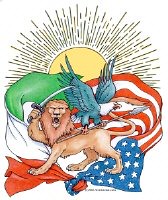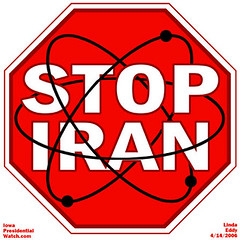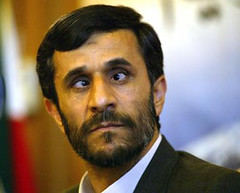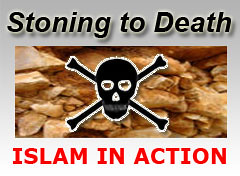Tuesday, September 04, 2007
GOOD OVERVIEW of ISLAMIC REPUBLIC'S INTELLIGENCE MINISTRY
Alan note: the new big boss, a thug called Ejdehi, who was one of the hands on torturers and murderers of the 1988 eradication of 30,000 political prisoners inside Iran's dungeons. HIs ruthless, sadistic, mindless infliction of pain and death earned him a reputation of a true follower of Islam and his top position today.
When Ayatollah Boroujerdi rose up in opposition to the regime during the past year, Ejdehi told Supreme Leader Ali Khamenei not to worrry and that he would present the dissident Ayatollah's head to him on a platter by morning.
Other than keeping the respected cleric alive (instead of beheading him) to torture him for months on end before a more recent death sentence closes the chapter on him and dozens of his supporters, now also facing the hangman's noose, he had the man kicked and beaten on his way to a bus after he was arrested, to add insult to injury.
And ransacked and pillaged everyting in the senior cleric's home.
Though some of the names mentioned below have been replaced by others of a similar ilk, the overview is still good.
What they do not realize is that the West and some of the opposition groups have penetrated the veil and know much more detail than the VEVAK big shots would like others to know.
As an example of the cracks in their system, I was able to obtain an abstract of a file of one of their infiltrators into the West.
Disinformation? No. Damned one of their own key people beyond repair.
He has not been arrested by the West but is being carefully and quietly monitored. What this otherwise secret person does is now giving away lots of pointers and information.
Berlin, May 06 – Iran’s Ministry of Intelligence and Security (MOIS) is ranked by experts as one of the largest and most active intelligence agencies in the Middle East, having masterminded 450 acts of terrorism throughout the world since the 1980s, yet it has been shrouded in so much mystery that apart from the occasional revelations by the Iranian Resistance, little has ever been made public about its operations and functions.
Its secret budget and unchecked power have turned it into one of the key pillars of the Iranian theocracy.
The MOIS is also one of the most secretive agencies in the world and its command structure is directly answerable to the Iranian regime’s Supreme Leader Ayatollah Ali Khamenei.
Intelligence Minister
The current Minister of Intelligence and Security, Hojatoleslam Ali Younesi, was appointed the Head of the Revolutionary Court of Tehran and later Head of the Politico-Ideological Bureau of Islamic Revolutionary GuardsCorps (IRGC) soon after the 1979 revolution that toppled the Shah.
In 1982 Younesi was appointed Religious Judge of the Military Revolutionary Tribunals. He was one of the founders of the MOIS. In 1986 he was appointed representative of the Supreme Leader to oversee the reconstruction of the Intelligence Directorate of the army upon the order of Ayatollah Khomeini.
In 1987 he became the Representative of the Acting Commander-in-Chief of the armed forces at the Intelligence Directorate of the army, and was appointed a religious judge.
The summer of 1988 marked a turning-point in Younesi’s rise within the clerical regime’s hierarchy. As one of the religious judges charged with implementing Ayatollah Khomeini’s fatwa to execute all “non-repentant”political prisoners, Younesi distinguished himself by presiding over one of the most ruthless tribunals, dispatching prisoners to their deaths summarily after trials that barely lasted more than five minutes.
Younesi’s performance in 1988 led to his promotion to one of the top slots in the Iranian regime’s judicial system and he became the head of the Judicial Organisation of the Armed Forces.
When in 1999 another Shiite cleric, Dorri Najafabadi, needed to be replaced as Minister of Intelligence and Security in the wake of the disclosure of MOIS agents’ murder of dozens of intellectuals and dissidents, Younesi was given the job.
Span of the Secret Network
The MOIS is a ministry only in name, for it operates under the direct supervision of the Supreme Leader. It is not accountable to either the cabinet or the parliament, has a secret budget, and stands above the law.Over the past two decades, it has grown into a huge machinery of political repression.
The Iranian regime’s use of terrorism as an adjunct to foreign policy has developed into an organised and professional activity over the last 25-years masterminded by the MOIS.
It has been used as a lever to gain advantages from Western countries or to exert more pressure on surviving opponents of the regime.
Many of Iran’s diplomats have a record of previous service with the MOIS, the IRGC, and other security agencies. The MOIS works in coordination with the Foreign Ministry in operations carried outa broad, making particular use of Iranian embassies worldwide as hubs for gatheringi ntelligence and diplomatic passes for agents involved in terrorista ctivities.
Internally, agents of the MOIS are rigorously tested before they are given security clearance and trusted enough to take part in operations which could potentially implicate the highest levels of the regime’s leadership to state corruption should someone decide to expose the agency.
Of the members, who themselves were hand picked from other security agencies inside the country, are first required to take part in the killing and torturing of dissidents, to ensure their loyalty to the regime and its Supreme Leader.
Only the most loyal cadres are inducted into the organisation.
Throughout the years, on a number of occasions, the MOIS has gone through “internal purges”, whereby agents showing weakness conveniently“ disappeared” or “committed suicide”.
From 1997 to 1998, after a series of gruesome murders of Iranian dissidents by MOIS “liquidators” became public,the then-deputy Intelligence Minister Saeed Emami was jailed on conspicuous charges, and later “committed suicide” in prison.
The regime thus prevented any leak of sensitive information about the MOIS operations, as this would have compromised the entire leadership of the Islamic Republic. Such internal purges and murders within the MOIS sparked a feud at the highest levels of the agency, which landed top officials from the losing side in prison.
_____
Iran: Profile of VEVAK’s Master Terrorist - Mohammad-Reza Iravani (a.k.a.Amir-Hossein Taghavi)
May 27 Iran’s sophisticated intelligence operations abroad are led by a shadowy figure at the helm of VEVAK
By Nader Shakiba
http://www.iranfocus.com/uploads/img4297a32d7ad2f.jpg
Berlin,Germany, May 27 (Iran Terror Website)
Hojjatol-Islam Ali Younessi, the Shiite cleric who runs Iran’s dreaded secret police, the Ministry of Intelligence and Security (known more commonly by its Persian acronym, VEVAK), did not try to conceal his anger and minced no words.
Appearing on Iran’s state-run television on the evening of March 25, he warned Iran’s main opposition group, the Mujahedin-e Khalq (MeK) with severe consequences for their continuing “mischief-making”.
“I have instructed my deputy today to lose no time in informing international organizations of the crimes of the [MeK], so that it would be documented that they have committed grave crimes,” the mid-ranking mullahsaid.
Younesi’s comments came on a night when Tehran and other major cities acrossthe country were in turmoil as throngs of young people heeded opposition calls to turn the traditional Persian fire festival into a night of anti-government protests.
The VEVAK chief (of that time) did not name his deputy and veryfew people outside the cloisters of power in Tehran are even aware of the identity of this shadowy man. But the Minister of Intelligence and Security was referring to Mohammad-Reza Iravani, the deputy chief of VEVAK.
Assassin, diplomat, agent-runner, senior bureaucrat, serial killer; these are just a handful of the many roles that Mohammad Reza Iravani has played in his twenty-six years of service in the security services of Iran’sclerical regime.
Known inside Iran’s officialdom by his pseudonym, Amir-Hossein Taghavi, he has a track record that makes him a cross between a Cold War spy master and a Mafia godfather. In one of the many grisly murders he has ordered or committed, he and his fellow VEVAK officers stabbed to death Darioush Forouhar, an Iranian dissident, and his wife Parvaneh in their home in Tehran in November 1998. Forouhar, 72, received 11 knifeblows; his wife’s body took 24 stabs.
Acting on Younesi’s instructions, Iravani has been coordinating a new disinformation campaign, targeting the MeK. He scored a propaganda coup on May 18, when Human Rights Watch put out a 28-page report on alleged humanrights violations by the MeK. Of the 12 “witnesses” Human Rights Watch cited in the report, every single one was familiar to Iravani. All were VEVAKagents operating in the Netherlands and Germany.
The latest disinformation coup, much like Iravani’s earlier successes in assassinations and infiltration of dissident groups, is sure to smooth his path to higher positions in the theocratic state.
Iravani has shown his political skills in high-level negotiations with French and German officials, in talks with representatives of the Irish Republican Army on joint operations, in sensitive discussions on Iraq with senior British officials, and in hammering out security deals with neighboring Arab officials.
But his steady and rapid rise to the highest echelons of power in clergy-ruled Iran has been marked with untold violence and bloodshed every step of the way.
When Sir Jeremy Greenstock, a senior British diplomat, visited Tehran in January 2004 to talk to Iranian officials on the situation in neighboring Iraq, he did not know that the bearded man who led the Iranian team in the talks was a top assassin and terrorist of VEVAK.
Iravani’s talks with Greenstock focused on the issues of some 4,000 members of the opposition MeK based in Iraq.
From hitman to VEVAK’s top gun
But there is more to Iravani than negotiating skills. Before he rose to senior positions in VEVAK, and even afterwards, Iravani did the dirty work of Iranian intelligence. He was one of the first to be recruited into the new Ministry of Intelligence and Security after it was founded in 1984 underthe direction of Ayatollah Mohammad Mohammadi Rayshahri.
Up until that time,the mullahs who ascended to power in 1979 relied on a motley mixture of two dozen autonomous intelligence and security agencies to hunt down their political opponents at home and conduct espionage abroad.
The Ministry of Intelligence and Security soon became a mammoth organizationwith a huge budget and thousands of full-time staff and tens of thousands of paid informers and agents.
In his first years in VEVAK, Iravani was a member of “special hit squads”.These teams were made up of professional assassins, highly proficient in the use of weapons and martial arts, who were assigned to capture or kill intended targets of VEVAK. Often, the targets were political activists,members of opposition groups, and dissidents.
Iravani soon distinguished himself among the VEVAK hitmen as a sanguinary killer and effective interrogator. Few political prisoners could withstand the particularly brutal torture methods that Iravani used.
Iravani was actively involved in the 1988 massacre of thousands of political prisoners. In July 1988, Ayatollah Ruhollah Khomeini issued a fatwa,ordering the execution of all political prisoners who would not “repent” and be willing “to die for Islam”. The text of the chilling fatwa was revealed years later in the Memoirs of Grand Ayatollah Hossein-Ali Montazeri, Khomeini’s anointed successor at the time of the massacre, who later fell from grace. (Alan note: fo rshowing disgust with this genocidal order).
No one knows exactly how many prisoners were sent to firing squads in the summer and autumn of 1988, but the killings left a deep scar on the national psyche of Iranians. In the words of Professor Maurice Copithorne, the last United Nations human rights rapporteur for Iran, the massacre constituted “one of the darkest chapters in the history of the Islamic Republic”.
VEVAK’s murder machine
By 1990, Iravani had risen high enough in the VEVAK hierarchy to become a director. He headed the General Directorate for Europe in the Ministry of Intelligence and Security for some time, before taking over as the chief of the General Directorate of Special Operations (GDSO).
At the time of Iravani’s promotion to the GDSO in the fall of 1992, GDSO was VEVAK’s most prestigious directorate.
It had an unlimited budget and was given priority over all other departments and directorates for personnel and facilities. Its director was in constant contact with the Minister of Intelligence and his deputy.
The President himself, (at that time) Hashemi Rafsanjani,was regularly personally informed of GDSO’s activities.
By that time, Ali Fallahian, a village mullah from the southwestern provinceof Khuzistan before the 1979 revolution, had become VEVAK chief.
Some VEVAK officials killed out of necessity, knowing that the clerical regime would not survive without an iron grip on society.
Fallahian was different. He enjoyed killing and took immense joy at torturing others. An indescribably brutal man even by the standards of VEVAK, Fallahian tortured and killed thousands of political activists, intellectuals, and even ordinary citizens during his fourteen years as the chief or deputy chief of VEVAK.
His motivations for these killings were often as much political as economic or even personal. He ordered the murder of businessmen who refused to bribe him.
A crude womanizer, he murdered some of the women with whom he had an affair to leave no witness behind.
One of these victims was Fatemeh Qaem-Maqami, an air hostess in Aseman Airways.
Fallahian met her on a flight to Mashad and forced the married woman to have an affair with him. According to the confessions of a former VEVAK official that was published in Iran, a few months later, Fallahian decided that Qaem-Maqami knew too much.
He ordered his deputy, Saeed Emami, to “liquidate” her. Emami arranged a meeting with the hapless woman and sent a VEVAK assassin, Saeed Haqqani, to kill her by shooting three bullets into her head and chest.
On the surface, Saeed Emami and Ali Fallahian were a world apart. While Fallahian was a rugged, rustic mullah with a diabolical taste forinflicting pain and suffering on others and an uncontrolled libido that claimed the lives of many women, Emami was an urbane, soft-spoken man who had spent much time abroad and, unlike his master, was well-versed in diplomatic niceties.
With their protégé, Iravani, this odd duo formed a dreaded triumvirate that ran VEVAK for much of the 1990s. Protected by then-President Hashemi Rafsanjani, this murderous clique left behind a long trail of murder, assassination, torture and corruption.
(Alan note: and there are some who call Fafsanjani andhis successor Khatami as "moderates". Compared to what? To dark savagery without any place in our modern world?)
Those years are remembered by Iranians as the time of the worst excesses of the clerical regime. Inside the country, VEVAK agents led directly by Emami and Iravani murdered more than 120 dissidents in what became known as“the serial killings”.
The killings were carried out in a brutal manner –victims were often mutilated - to shock and subdue a restless society that often seemed to be on verge of revolt against the ruling theocracy.
Assassination and Disinformation
But it was in the chain of assassinations abroad that GDSO came into its own. With the considerable resources of the Iranian government in Europe at their disposal, GDSO hitmen struck repeatedly in Geneva, Vienna, Istanbul, Paris, Rome, Berlin, Stockholm, and Nicosia, gunning down Iranian dissidents in cold blood.
A Berlin court ruled in April 1997, after a three-year trial,that the assassinations were carried out on orders issued by a secret committee made up of Supreme Leader Ali Khamenei, then-President Hashemi Rafsanjani, then-Foreign Minister Ali-Akbar Velayati, and then-VEVAK chief Fallahian.
VEVAK’s brief in the 1990s was to decimate the Iranian opposition in exile, focusing particularly on the MeK and the political coalition to which it belonged, the National Council of Resistance of Iran.
Assassination of opposition figures was part of the strategy, but a larger component of this strategy was a vast disinformation campaign that began after the first GulfWar in 1991.
The plan, approved by the Supreme National Security Council and given to VEVAK to implement, was a sophisticated campaign to recruit former membersof the MeK and accuse the group of a range of abuses and criminal activities. These included human rights violations, complicity withSaddam Hussein’s regime in the suppression of Kurds and Shiites, and concealment of Iraq’s weapons of mass destruction in MeK camps.
(Alan's note: Iran knew the weapons of mass destruction were there despite efforts by Democrats and left-wingers to deny their existence).
The clerical leaders’ hope was that by discrediting the principal Iranian opposition group through such a disinformation strategy, they would enhance their regime’s political stability and convince the outside world that there was no alternative to clerical rule in Iran.
The strategists in Tehran thought that once the MeK lost its legitimacy in the eyes of its supporters, it would lose its stature and become more vulnerable to VEVAK attacks.
GDSO was given operational responsibility for the plan.
Working closely with his boss, Saeed Emami, Iravani spent months in Europe in the early1990s to recruit former MeK members for the new plan. By the mid-1990s, VEVAK had used many threats and incentives to recruit a dozen former MeK members and supporters living in Europe.
Hundreds more refused to cooperate withVEVAK.
(Alan note: more recently the VEVAK campaign focused on gaining control of Iranian overseas news media such a multitude of radio and TV stations that sprung up like mushrooms and either co-ercing those in charge by threatening their families still back home or buying them off or a a combination of both.
Payment to these station owners or operators took the form of carpets not cash or when the amounts were too big, including them in real esate deals where they acquired ownership or partnership without contributing any investment.
The recent intent to ban the import of Persian carpets or rugs into the USA may make "off the book" payments more difficult for the Islamic regime.
Reports indicate that almost every mass media operator has been compromised in one way of antoehr or bought off. One Iranian TV station in the USA has not been able to explain an intercepted letter from Supreme Leader Khamenei ordering a payment of about $2,500,000 to that station for "loyal services during the previous year").
The new recruits’ handlers were mainly VEVAK officers working under diplomatic cover in the Iranian embassies in Bonn and the Hague. But Emami and Iravani kept a close tab on everything from Tehran. They would often arrange to meet new recruits in Southeast Asia – Singapore and Kuala Lumpur being VEVAK’s favorite venues – to evade detection by Iranian exiles orWestern security services.
One VEVAK defector, Jamshid Tafreshi, later revealed how Iranian intelligence conducted its recruitment and running of agents in Europe and North America.
VEVAK officers paid for his return trips to Singapore, where he would meet and be indoctrinated by Emami and Iravani, who used pseudonyms to disguise their identities.
According to defectors, VEVAK’s top officials used their trips abroad, particularly to Southeast Asia, to indulge in sexual exploits. Ironically,the same officials often framed political dissidents in Iran for such “crimes” as possession of pornographic materials to put them in jail.
Emami and Iravani would guide the ex-MeK recruits to give interviews and lectures on a range of allegations against the MeK.
Tafreshi was once asked to deliver a speech to a meeting in Cologne and he was given a paper prepared by VEVAK to read out. The paper alleged that Saddam Hussein concealed his secret weapons of mass destruction in MeK facilities in Iraq and accused the MeK of being a stooge of his regime.
Once Tafreshi delivered the speech prepared for him by VEVAK, Iranian intelligence instructed the state-run media to give wide coverage to the report, which then filtered back through to the West.
Iravani’s top recruit in those years was Karim Haqi, a former MeK member who had been brought to Europe by the group after he decided to leave the MeK. Haqi became a key agent of VEVAK in Europe and his handler reported directlyt o Iravani.
Extreme measures
By 1994, the Supreme National Security Council was putting pressure on VEVAK to step up its anti-MeK activities. Maryam Rajavi, a prominent exile, had been leading a successful political campaign against Tehran after her nomination as provisional president by the Paris-based National Council of Resistance of Iran.
To tarnish Rajavi’s image and remove her threat, DGSO resorted to some extreme measures. On the military side, VEVAK and the Islamic Revolutionary Guards Corps worked jointly on a “super mortar” project that could lob 400 pounds of high explosives at a target several miles away. Aftersuccessful tests, a 320mm super mortar and its missile were camouflaged as food cargo and placed on board an Iranian cargo ship bound for Hamburg.
A DGSO crack assassination team had been trained to receive the cargo in Hamburg, transfer it to France, and use the mortar to devastate Maryam Rajavi’s villa north of Paris.
The elaborate plan hit a snag when Belgian police uncovered the super mortar and the explosives during an inspection as the ship anchored in the port of Antwerp on its way to Hamburg. The blow was a serious setback for VEVAK.
(Alan note: while the MEK is still listed as a tgerrorist organization by the USA administration, France recently removed them from that category and returned all the MEK funds which France had confiscated as part of the naming of the MEK as a terrorist group).
In May 1995, Iravani made a hasty trip to Bonn to talk to German officials after VEVAK learnt that Maryam Rajavi was to speak at a public rally of Iranian exiles in Dortmund, scheduled for June 16.
Under Fallahian’s instruction, Iravani’s real mission was to organize an attempt on Rajavi’s life during her visit to Germany.
He used VEVAK’s European headquarters on the third floor of the Iranian embassy in Bonn tocoordinate the attack. Unknown to him, German counter-intelligence had a mole in the embassy and discovered the plot to assassinate Maryam Rajavi.She was barred from attending the rally and Bonn quietly expelled two VEVAK officers working under diplomatic cover. The story was leaked to the New York Times.
French deal frees assassins
In December 1993, Iravani was part of a high-level delegation that made an unscheduled visit to Paris. Mohammad Hejazi, a cleric who runs Khamenei’s Special Office for Security, and Alireza Moayyeri, a former Revolutionary Guards commander who was later appointed as ambassador to France and then became Rafsanjani’s political advisor, were other members of the delegation.
They conducted urgent negotiations with French officials over the fate oft wo VEVAK officers who had been arrested in France. The clerical regime’sleaders had instructed the delegation to have the two men returned to Iran at whatever cost.
Both men were members of the DGSO team that assassinated NCRI official Kazem Rajavi in Geneva in 1990. The French government ignored urgent extradition requests from the Swiss government and returned the two men to Iran, after striking a deal with Tehran’s envoys.
Had the two men been handed over to Bern and put on trial, the Iranian regime would have suffered a blow no less than the one it received in the Berlin trial of assassins of four Iranian Kurds.
Once the crisis over VEVAK’s arrested officers was over, Iravani used his visit to Paris to meet secretly with representatives of the Irish Republican Army. He offered to provide them with advanced communications equipment, Semtex plastic explosives, eight Stinger missiles, 400 handguns, 100 Uzi submachine guns, a large quantity of ammunition, and a large sum of money if they would assassinate three Iranian opposition figures in Europe.
The two sides did not reach an agreement and the deal fell through.
VEVAK’s Special Ops inside Iran
Throughout those years, DGSO’s domestic branch was as active as the directorate’s external arm. In June 1994, Tehran blamed the MeK for a bomb blast in the shrine of Imam Reza that killed and wounded several pilgrims.
Despite strong denials by the MeK, the Iranian regime made extensive efforts to have the MeK condemned by other governments for the bomb attack.
Yearslater, former VEVAK officials revealed that the bombing had been stage-managed by DGSO as part of the campaign to push Western governments to take action against the MeK.
Another spectacular operation by DGSO in Iran was the murder of two Anglican bishops and a priest. An elaborate plan was used to pretend that theMeK had murdered the church leaders.
VEVAK forced three girls, all MeKsupporters who had been in prison for some time, to confess before television cameras that they carried out the murders.
But independent investigations,including one by the UN rapporteur on religious freedom, found the charges to be unsubstantiated.
Years later, former VEVAK officials again unveiled the killings as the gruesome work of VEVAK carried out by DGSO under the direction of Emami and Iravani.
Iravani’s work as director of DGSO was not limited to anti-MeK disinformation or assassinations, although this took much of his time. His DGSO played a central role in the grisly murder of dozens of dissidents in Iran during those years.
VEVAK defector Jamshid Tafreshi has described how Iravani and his men murdered Hamid Hajizadeh, a poet and teacher, at his home in the southern city of Kerman.
Hajizadeh was stabbed 38 times.
The VEVAK team also stabbed his 10-year-old son to death before they left.The crime was so horrendous that the local police inspector, who arrived at the scene of the crime after VEVAK assassins had left, burst into tears...
Subscribe to:
Post Comments (Atom)














No comments:
Post a Comment